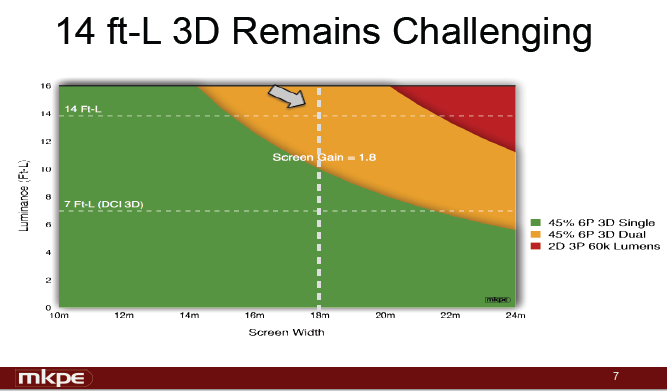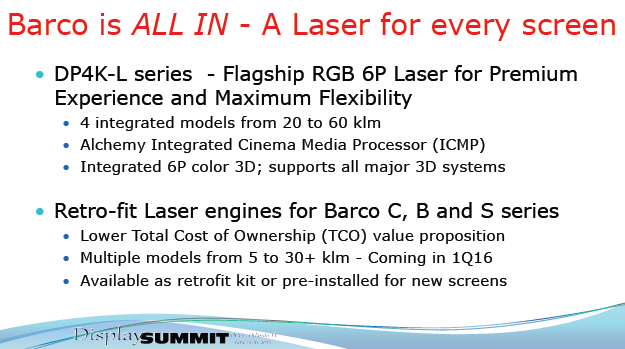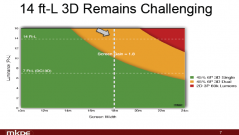 The rest of the day was devoted to panel sessions and the first was on cinema. The moderator was Chris Chinnock and the panel was comprised of:
The rest of the day was devoted to panel sessions and the first was on cinema. The moderator was Chris Chinnock and the panel was comprised of:
Bill Beck, The Laser Guy from Barco, Richard McPherson, Sr. Product Manager NEC, Michael Karagosian, President MKPE and Don Shaw, Senior Director, Product Management Christie.
The first point of agreement was that 3D is not dead – it is still alive in the cinema, but you have to deliver a high quality image and that is a challenge, even with lasers, as we saw in the presentation from RealD.
Laser will not be sold to theatre-goers as a simple upcharge, but will become part of a Premium Large Format (PLF) experience.
14fL (the standard for 2D onscreen brightness) is still a target for 3D cinema, but today brightness is typically 6fL max in reality and in many cinemas, way below. That works for novelty 3D presentations, but not for long term repeat 3D viewing. You really need content that is graded for 6fL (Fox has 14fL graded masters for those cinemas that can cope with it, we heard).
There was a discussion about whether laser colour is better and it was agreed that saturation and brightness uniformity are better. Chinnock asked if DCi Laser and Xenon should look the same? They won’t was the clear answer. For example, brightness uniformity is 75% in the corner for Xenon, but 95% for laser and the images also look different with high gain screens. Metamerism can be an issue with lasers. “The laser reds really pop out” said Shaw, but it comes back to artistic intent as to whether this is a good thing.
Inside Out is a new move with colours that are “spectacular” if you can get to see it in Dolby Vision. Karagosian said that Dolby Vision is the “gold standard” at the moment. If you give movie makers better projectors, they will create for them, but for now, Xenon is typically used for mastering, although that may change.
Dolby uses the performance of laser to boost peak brightness, while Imax uses laser to support bigger screens. Going high peak brightness in 3D is very expensive in laser, Beck said. 22fL is the target for on-screen brightness for Imax – but 8K or 10K:1 contrast is also desired. Speckle can be an issue with lasers, although there seem to be solutions (even if you have to vibrate the screen!).

TomorrowLand and Jurassic Park are new titles that have aspect ratios which are not standard. That was not a studio decision, it was a film maker decision and was taken regardless of the pain that it will cause exhibitors.
Chinnock asked “If there is a content pipeline for HDR at home, how can cinema compete”? Beck asked, “Can we agree it has to be laser?”. Studios will make HDR content to be shown on TVs, and theatres will have to react to stay competitive as an experience.
There are a couple of projectors that have “HDR”, but the standards vary and there are no definitions in projection. “What do you mean by HDR?” should be a question. Laser projectors are better in contrast, but an evolution from Xenon, not a revolution, said Shaw.
Imax is challenged by the large size. True HDR might take 50fL and they have “big sheets” to illuminate.
Shaw of Christie wondered if it is possible to roll out a “low cost” HDR projector to movie theatres globally in the next three years? “What about using direct LED instead of projection” was a question. The panel was not sure, content protection could be an issue as LEDs have very different controllers, but it was pointed out that content may not come from Hollywood. Not all content comes from the US these days! (Leyard told me at Infocomm that it is quoting for a huge cinema based on LED in the US and I would be amazed if China is not trying this – Man. Ed.)
There was a discussion about the penetration of RGB laser and the suggestion was made that there might be 1,000 worldwide, maybe, in the next three years?
Laser phosphor is a different case. NEC is currently aiming for 24′ to 30′ screens to replace lamps. Later there will be higher brightness versions for bigger screens. NEC sees LPD and RGB laser as different opportunities.

Last year, at the summit, Beck said that Barco is “all in” on laser. Laser for all screens and Laser Phosphor (LP) for smaller ones. All the different projectors in the S, B and C series will eventually be retrofittable with laser or LP. Barco is marketing the retrofit as TCO-neutral over the lifetime – the opex savings in labour/lamps/power should offset the cost of the new light source. The brightness is more consistent, he said (although brightness does, of course, decline over the lifetime).
Blue laser-based phosphor projectors are currently weak in red, said Shaw. McPherson said that LP can meet the DCI P3 gamut spec, but the saturation is lower than with RGB laser. There were a number of questions about lumens and gamut.
Beck of Barco would not say what the phosphor material is in the Barco LP projectors. Cinemeccanica is another company that is able to offer retrofit LP solutions, but the panel warned that this might threaten safety. For example, Christie has an infrared “back channel” that signals back to the laser source that it is correctly optically coupled to the projection engine. Shaw said that he could foresee a potentially big problem with too much light coming into the engine from third party laser upgrades.
Beck said that maker’s warranties will be invalidated. Delivering laser through fibre is a good solution, but it can be dangerous as the power going through the fibre can be “enough to cut metal”.
LIPA has struggled to get lasers accepted in the US and Beck asked that the initiative to get acceptance of laser projectors should continue. There are no regulations that Beck is aware of for high wattage usage. NEC said that there is internal laser scatter within the optical engine, and you have to take that into account. At the moment, the FDA has to approve laser projectors and may not like the idea of two different makers in a retrofit application.
Measurement of lasers is an issue, as well. In the real world, there are spectral issues, measuring devices were almost certainly developed for more broadband light sources. Meters may, or may not, be able to measure XY co-ordinates accurately because of the narrow spectrums. Broader spectral distribution is generally good because it reduces speckle and metamerism. You may find in the future that laser makers may come out with light, “equivalent” to Xenon in spectral distribution.
LIPA is working on a speckle measurement code of practice, said Beck.
There was a discussion of metamerism (different colours being perceived by different users, although the colour measurement is the same – Man. Ed.). Often metamerism shows as a colour cast that can be clearly seen. Beck said that there metamerism is a real issue, but it is a “second or third order” effect and even where there are differences, they are typically within the DCI/P3 tolerance, so he doesn’t expect issues in theatres, even if it causes some problems in grading suites.
DCI/P3 gamut material was developed by Hollywood and was developed side by side with film and DCI/P3 gamut with a TI DLP engine has become the new standard for colour cinema. So far, no single standard has become established for laser.
High frame rates (HFR) was the next big topic. Beck said it’s a shame that the Hobbit gave HFR a bad name… Hollywood “runs to” or “away from” the good. Wide Colour Gamut and HDR give a bigger bang for the buck than high frame rates. HDR and WCG makes everything more obvious, but that applies to the good and the bad. Karagosian said that a couple of movies are being recorded at 120Hz – Douglas Trumbull’s name was mentioned as one source.
It doesn’t make sense to run all content at the same frame rate and variable frame rates will arrive, eventually. Somebody is recording some content for display and testing later in the year. Digital Cinema is now 10 years old and now we’re at the edges of what was defined for the start of the technology. McPherson said that he simply can’t watch 3D at 24fps – he needs higher rates.
Finally, there was a good question asking whether there was momentum from rental/staging/theme parks for laser? Christie said that it has made more sales of laser projectors to theme parks than cinemas. Beck said the continued funding of LIPA is essential, because regulation could be a real barrier to adoption.

